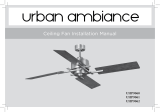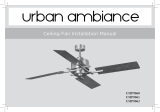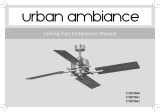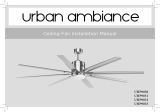Page is loading ...

GENERAL INSTALLATION & OPERATION INSTRUCTIONS
IMPORTANT SAFEGUARDS:
1. To ensure the success of the installation, be sure to read the instructions and review the diagrams thoroughly
To ensure the success of the installation, be sure to read the instructions and review the diagrams thoroughly
before beginning.
before beginning.
2. To avoid possible electric shock, be sure electricity is turned off at the main power box before wiring.
To avoid possible electric shock, be sure electricity is turned off at the main power box before wiring.
All
electrical connections must be made in accordance with local codes, ordinances and/or the National Electric
Code. If you are unfamiliar with the methods of installing electrical wiring and products, secure the services of a
qualified and licensed electrician as well as someone who can check the strength of the supportive ceiling
members and make the proper installation(s) and connections.
3. Make sure that your installation site will not allow rotating fan blades to come in contact with any object. Blades
should be at least 7 feet from floor.
4. When mounting on a ceiling outlet box, an approved box UL listed as "suitable for fan support
"suitable for fan support
of 35 lbs (15.9
of 35 lbs (15.9
kg) or less
kg) or less"
is required. The box and its supporting members must be able to support the moving weight of the
fan's listed weight. The box must not be able to twist or work loose. Installation on a concrete ceiling should be
performed by qualified personnel.
5. Blades should be attached after motor housing is hung and in place. Fan motor housing should be kept in the
carton until ready to be installed to protect its finish. If you are installing more than one ceiling fan, make sure
that you do not mix fan blade sets,
do not mix fan blade sets,
as each blade is part of a weighted set.
6. After making electrical connections, spliced conductors should be turned upward and pushed carefully up into
outlet box. The wires should be spread apart with the common conductor and the grounding conductor on one
side of the outlet box, and the "HOT" wires on the other side.
7. Electrical diagrams are for reference only. Light kits that are not packed with the fan must be UL listed and
should be installed per the light kit's installation instructions.
8. After fan is completely installed, check to make sure that all connections are secure to prevent fan from falling
and/or causing damage or injury.
9. The fan can be made to work immediately after installation - the bearings are adequately charged with grease so
that, under normal conditions, further lubrication should not be necessary for the life of the fan.
10. To operate the reverse function on this fan, press the reverse button while the fan is running.
1
Weight of Fan: 18.70 Lbs

IMPORTANT SAFETY PRECAUTIONS
2
Thank you for choosing a Regency Ceiling Fan. You have chosen the best!
Your new ceiling fan has been designed to provide many years of service and enjoyment.
• Disconnect power by removing fuse or turning off circuit breaker before installing the fan and/or optional lighting.
Disconnect power by removing fuse or turning off circuit breaker before installing the fan and/or optional lighting.
• Support directly from building structure.
• To reduce the risk of fire, electric shock, or personal injury, mount to outlet box marked "acceptable for fan
"acceptable for fan
support
support
of 35 lbs (15.9 kg) or less"
of 35 lbs (15.9 kg) or less"
and use mounting screws provided with the outlet box. Most outlet boxes
commonly used for the support of lighting fixtures are not acceptable for fan support and may need to be replaced.
Consult a qualified electrician if in doubt.
• Do not use an incandescent light dimmer. Do not use this fan with any transformer type fan speed control device.
• To reduce the risk of personal injury, do not bend the blade arms when installing them, balancing the blades or
cleaning the fan. Do not insert any objects(s) between rotating fan blades.
NOTE:The important precautions, safeguards and instructions appearing in this manual are not meant to cover all
NOTE:The important precautions, safeguards and instructions appearing in this manual are not meant to cover all
possible conditions and situations that may occur. It must be understood that common sense, caution and
possible conditions and situations that may occur. It must be understood that common sense, caution and
carefulness are factors which cannot be built into this product. These factors must be supplied by the person(s)
carefulness are factors which cannot be built into this product. These factors must be supplied by the person(s)
installing, caring for, and operating the unit.
installing, caring for, and operating the unit.
Warnings:
Warnings:
TOOLS AND MATERIALS REQUIRED
• Phillips screwdriver
• Blade screwdriver
• Wrench or pliers
• Wire cutter
• Stepladder
• Wiring supplies as required by
electrical code

3
1. Fan blades (3)
2. Hanging bracket
3. Ceiling canopy
4. Canopy screw cover plate
5. Downrod/ball assembly
6. Collar cover
7. Fan housing with motor (Remove rubber shipping supports around motor, if included on your fan. Save screws.)
8. Mounting plate
9. 17W LED light kit
10. Glass shade
11. Transmitter+holder+2 mounting screws
12. 12V battery
13. Hanging bracket mounting hardware (wood screws, screws, lock washers, washers, wire nuts)
14 Blade to blade arm screws, w/flat washers and lock washers (7)
15. Balance kit
NOTE:
NOTE:
Design of parts shown above may look slightly different for your specific model of fan.
UNPACKING YOUR FAN
1. Unpack your fan and check the contents. Do not discard the carton. If warranty replacement or repair is ever
necessary, the fan should be returned in original packing. Remove all parts and hardware. Do not lay motor
housing on its side, or the decorative housing may shift, be bent or damaged.
2. Examine all parts. You should have the following:
1
2
6
3
4
5
14
13
12
15
7
8
9
10
11

PREPARATION
PREPARATION:
Verify you have all parts before beginning the installation. Check foam insert closely for missing parts. Remove motor
from packing. To avoid damage to finish, assemble motor on soft padded surface or use the original foam inset in
motor box. Do not lay motor housing on its side as this could result in shifting of motor in decorative enclosure
Do not lay motor housing on its side as this could result in shifting of motor in decorative enclosure
.
Caution
Caution
: To avoid possible electrical shock, be sure
electricity is turned off at the main power box before
wiring. All wiring must be in accordance with National
and Local Electrical Codes and the ceiling fan must be
grounded as a precaution against possible electric shock.
1. Locate ceiling joist where fan is to be mounted, being
sure location agrees with the requirements in the mini-
mum clearance section of this guide. Wood joist must be
sound and of adequate size to support 35 lbs. (See Page 1,
Items 3 and 4).
2. If not already present, mount a UL listed outlet box
marked "suitable for fan support" following the instruc-
tions provided with the outlet box. The outlet box must be
able to support a minimum of 35 pounds.
3. Attach hanging bracket to outlet box using screws
provided with the outlet box.
4
Parts identification on assembled fan
INSTALLING THE HANGING BRACKET
Ceiling Fan
Outlet Box
Hanger
Bracket
Outlet Box
Screw
Flat Washer
Spring Washer
Fig. 1
Blade
Light Kit
Collar Cover
Downrod
Canopy
Motor Housing

INSTALLING THE FAN
5
1. Carefully support fan body (motor) in its styrofoam packing with the mounting collar (where the wires come out)
facing upward.
2. Loosen the two set screws and remove the downrod pin and cotter pin from the top coupling of the motor assembly.
3. Remove ball from the downrod by loosening set screw in the side of the ball. Slide ball down and remove ball pin;
remove ball.
4. Feed the wires from top of fan through end of the downrod of choice and set end of downrod into mounting collar so
the hole in the downrod lines up with the hole in the side of the mounting collar.
5. Insert downrod pin through holes in mounting collar and downrod; slip cotter pin through small hole in end of
downrod pin to hold downrod in place.
6. Tighten jam screws against downrod using a large flat blade screwdriver to ensure a tight fit against downrod. Tighten
nuts against mounting collar.
Hook-up (3)
Wires
Ground
Wire
Ball
Canopy
Downrod
Mounting Collar
Downrod Pin
Top of
Fan Body
Collar Cover
Canopy Screw
Cover Plate
Security Screws
Cotter
Pin
NOTE
NOTE
: Fan has 6 feet of hook-up wire in case
you are using a long extension downrod. Wires
can be cut so only 8 inches or so extend beyond
. Feed wires through the collar cover, canopy
screw cover plate and canopy, then slide both
over downrod to lay on top of collar rubber
cover. It will be attached to ceiling later.
8 . Feed wires through ball and slide ball over
downrod, past hole in the top end of the
downrod. Insert ball pin (removed in step 3),
slide ball up, and tighten set screw to secure
ball in place.

INSTALLING THE FAN
ELECTRICAL CONNECTIONS
WARNING: To avoid damaging the blade arms and blades,
do not install them onto fan until fan is fastened to ceiling.
1. Lift ball/downrod/fan into hanging bracket opening.
NOTE: The tab opposite hanging bracket opening should fit
in slot on ball.
WARNING: To avoid possible electrical shock be sure electricity is turned off at the main fuse or breaker box before
wiring.
1. Connect the ground wire from the household to the green ground wire(s) of the fan. (Fig. 4)
2. Connect the fan supply (black) wire to the black household supply wire as shown in Figure 4.
3. Connect the neutral fan (white) wire to the white neutral household wire. (Fig. 4)
4. After all splices are made, check to make sure there are no loose strands. As an additional precaution we suggest to
secure the plastic wire connectors to the wires with electrical tape.
6
Slot
Tab
Fig. 3
Outlet Box
Black ("AC IN L")
White ("AC IN N")
White (Neutral)
Black (Motor)
Fig. 4
Green or bare
copper (ground)
Ground (green)
(Connect to ground wire on
hanger bracket if no house
ground wire exists.)

Fasten blade to motor with provided flat washers, lock washers and blade mounting screws. Repeat procedure for
remaining blades. Make sure screws are TIGHT! Loose motor screws can contribute to unnecessary hum during
operation.
NOTE:
NOTE:
Cordless power screwdrivers are NOT
NOT
recommended, as they tend to strip the heads of the screws and usually
will not fully compress the lock washers on the motor screws. Use a large flat blade screwdriver for final tightening to
fully compress the washers. This will help ensure proper alignment of the blades and noise-free, wobble-free running.
7
FINISHING THE INSTALLATION
BLADE ATTACHMENT
1. Tuck connections neatly into ceiling outlet box.
2. Remove one of the hanger bracket screws from the bottom of the
hanger bracket and loosen the other screw a half turn from the
screw head.
3. Slide the canopy up to the hanger bracket and place the key hole
on the canopy over the loose hanger bracket screw on the hanger
bracket. Turn the canopy clockwise until it locks in place at the
narrow section of the key holes.
4. Align the circular hole on the canopy with the remaining hole on
the hanger bracket. Secure the hanger bracket screw previously
removed into the hole, and tighten the two hanger bracket screws.
5. Attach the canopy screw cover plate to the hanger bracket screw
heads on the bottom of the canopy by inserting the screw heads
into the key slots in the canopy screw cover plate and rotating the
canopy screw cover plate clockwise.
WARNING:
WARNING:
Make sure the hook on the hanging bracket properly sits
in the groove in the downrod ball before attaching the canopy to the
bracket by turning the housing until it drops into place.
Canopy
Screws
Canopy Screw
Cover Plate
Ceiling Fan
Outlet Box
Hanger
Bracket
INSTALLING THE FAN
Screws
Blades
Flat washers
Lock washers

INSTALLING THE LIGHT KIT AND GLASS SHADE
8
NOTE:
NOTE:
Be sure the power is off before installing.
1.Remove one of the three screws on the mounting hub located
on the fan motor. Loosen the other 2 screws. (Do not remove)
(Fig. 1)
2. Pass the light wires through the center hole of the mounting
plate.
3. Place the key holes on the mounting plate over the 2 screws
previously loosened, turn the mounting plate until it locks in
place at the narrow section of the key holes. Secure by tightening
the 2 screws previously loosened and the one previously removed.
4. Remove one of the three screws on the mounting plate located
on the fan motor. Loosen the other 2 screws. (Do not remove)
(Fig. 2)
5. While holding the LED light kit under your fan, make the
polarized plug connections: (Fig. 2)
- Red to white
- Black to black
6. Tuck connections neatly into mounting plate. Place the key
holes on the light kit over the 2 screws previously loosened, turn
the light kit until it locks in place at the narrow section of the key
holes. Secure by tightening the 2 screws previously loosened and
the one previously removed.
7. Raise the glass shade against the LED light kit and turn clock-
wise until snug, DO NOT OVERTIGHTEN.
8. Restore power and your light kit is ready for operation.
Fig. 1
Fig. 2
Light Wires
Mounting Hub
(bottom of motor)
Mounting plate
Screws
Screws
Mounting plate
Light Kit
Wire connectors
Glass shade

OPERATING YOUR TRANSMITTER
Fig. 1
Fig. 2
ON ECE
1234
ON
D
ON ECE
ON
D
9
Your DC brushless motor is equipped with a automatically learned type
remote control.(If two fans or more in a house, it is recommended that you
not use the factory code settings. Change codes setting to any other combina-
tion of dip switch setting to avoid fan interference issues, but users need to do
control setting process as below once the code setting is changed. Please refer
the "E" "SET" code setting button section.) Restore power to ceiling fan and
test the transmitter as below for proper operation:
Install one 23A/12V battery (included). To prevent damage to transmitter,
remove the battery if not used for long periods of time (Fig. 1)
A. I, II, III, IV, V and VI button:
These six buttons are used to set the fan speed as follows:
I = minimum speed
II = low speed
III = medium low speed
IV = medium speed
V = medium high speed
VI = high speed
B. button:
This button turns the fan off.
C. Reverse button:
This button is to control fan direction
D. Light button
This button is to control light. Switch the “D” and “ON” dip switch on the
back of transmitter to decide the light in “ON/OFF” or “Dimmable” condition.
E. SET code setting button:
Follow the below steps to set the remote control:
The auto learning function will only mandate within 60 seconds when turning
the fan’s AC power ON.
a) Select desired frequency from the back of transmitter.
b) With the fan’ s power off, restore power to the fan. From the back of the transmit-
ter, Press and hold “SET” button for about 5 seconds and release. If the light kit is
installed, the light kit will flash twice and the signal light on the remote control will come
on when the button is pressed. The fan has completed the pairing process with the remote
control and is ready for use.
NOTE: If the self calibration test failed, turn the AC power off; restore power
and process the self calibration test again.
NOTE: During self calibration test, the remote is non-fuctional.
NOTE: The learning frequency function and self calibration test will continue
to retain the last set frequency and calibration set even when the AC power is
shut off. If the frequency is changed the self calibration test will occur again.
F. “D” and “ON” dip switch:
The “ON” selection is the light dimmable selection and is to be used with all
bulbs except for CFL bulbs. The “D” selection is the light ON only (no dim-
ming function) and is to be used with CFL bulbs as CFL bulbs in most cases
cannot be used with dimming controllers.

10
Fig. 1 Fig. 2
This receiver provides the following protective function:
1. Lock Rotor Position: The DC motor has a built-in safety against a stalled or locked rotor condition (stalled blade
rotation). If there is an obstruction or fault with the motor, the current monitoring function will automatically turn
power off to the motor after 30 seconds. Remove the obstruction and turn the AC power off. Restore power and re-
start fan motor.
2. Over 80W protection: When the receiver detects motor power consumption which is greater than 80W, the
receiver power will be stopped and operation will immediately discontinue. Wait for 5 seconds and then turn the
receiver power back on.
Speed settings for warm or cold weather depend on factors such as room size, ceiling height and number of fans.
NOTE: To operate the reverse function on this fan, press the button while the fan is running.
Warm Weather (forward):
A DOWNWARD airflow creates a cooling effect as shown in Figure 1. This allows you to set your air conditioner on a
warmer setting without affecting your comfort.
Cool Weather (Reverse):
An UPWARD airflow moves warmer air off the ceiling area as shown in Figure 2. This allows you to set your heating
unit on a cooler setting without affecting your comfort.

INSTALLING THE TRANSMITTER HOLDER
1. Remove the cover from the holder.
2. Attach the holder with the two screws provided.
3. Replace the cover into holder.
Cover
Holder
Screws
CARE AND CLEANING
Periodically it may be necessary to re-tighten blade to blade arm screws or blade arm to motor screws to prevent
clicking or humming sound during operation. This is especially true in climates with broad temperature and
humidity ranges.
When dusting the blades, you must support the blade to prevent bending - no pressure should be applied to the
blades. If you experience any flaws in the operation of your fan, please check the following points.
11

TROUBLESHOOTING - IN CASE OF DIFFICULTY
CAUTION:
CAUTION:
Switch off power supply before carrying out any of these checks.
1. If fan will not start: Check main and branch circuit breakers and/or fuses. Check line wire connections to fan
housing wiring. Make sure forward/reverse switch is set to one or the other position, not stuck in between.
2. If fan is noisy: Check and make sure that all screws in motor housing are snug (but not over tight). Check that the
screws securing blade arms to the motor are tight. Check that wire connectors in switch housing are not rattling
against each other or the interior wall of the switch housing. Check that all glassware is finger tight and that
bulb(s) are well held in the sockets, if a light kit is used. Check that the canopy is firmly attached to hanging
bracket and not vibrating against ceiling.
3. If fan wobbles: Check that all blades are firmly screwed into motor housing. Check to make sure that light kit (if
present) is firmly attached to switch housing and that all glassware and shades are fastened properly. Wobble can
also result from even the smallest deviations in distance from blade tip to blade tip. If measurements from blade tip
to blade tip are not equal, loosen screws connecting blade to blade arm one at a time and adjust blade(s) so that
distances are equal. Interchanging adjacent blades may redistribute mass and result in smoother operation. Most
wobble can be traced to a loose electrical box or mounting bracket. Make sure these are tight and the ball is
completely seated in the bracket.
12
THANK YOU FOR PURCHASING A REGENCY CEILING FAN.
Write to us at:
Regency Ceiling Fans
P.O. Box 730
Fenton, MO 63026
Visit us on the Web at: www.regencyfan.com
12/17 Regency Ceiling Fans
/











